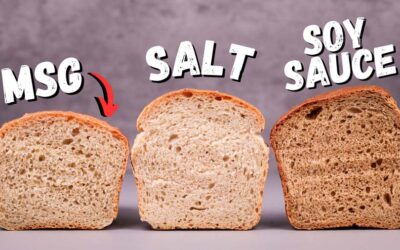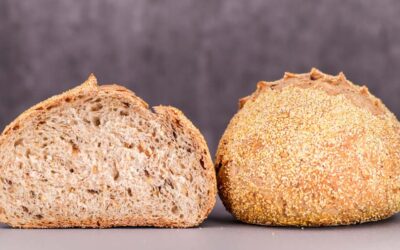Most people assume that because I have a YouTube channel about breadmaking I eat a lot of bread all the time. That is not quite true. I only sample what you see in my videos, and I rarely bake when I’m not recording. A lot of the baked goods I make are shared with work colleagues and friends.
So, baking twice a week and only sampling the baked goods most of the time makes my bread consumption quite low. I just enjoy the process of breadmaking, and I enjoy sharing my experiences with you.
There are however many of you who do eat bread daily. And there are others who would like to have homemade bread daily but cannot yet figure out an efficient and convenient way of getting that done. We all have things to do and waiting around for bread to rise may not be an option for a lot of busy people nowadays. Cold fermentation has been my go-to method for some time now because it allows for mid-week bakes with very little attention dedicated to the dough as it ferments.
Being able to just mix dough and pop it in the fridge until next day makes my life so much easier and I know that a lot of you are enjoying the benefits of cold fermentation too. It is not only easy and convenient, but it also improves the flavour and keeping quality of the bread.
If we want a constant supply of fresh bread, we need to devise a baking plan.
I imagine that most of the people who eat bread every day usually do it in sandwich form, so that is why I chose sliceable loaves for this demonstration. A medium sized loaf of bread can be consumed in 3 – 4 days while still being fresh enough during that period. That means if we bake twice a week, we could always have fresh bread available.
Of course, I appreciate that not everyone is a sliced bread enthusiast. You can use this baking system for any recipe that you like. The system can be modified and changed in ways to not only fit your recipe but also your schedule. Instead of baking twice a week you could bake once a week. Or you could make a big dough, stick it in the fridge and pull a piece off of it to bake a fresh bread every day provided you have enough fridge space.
I made my choices considering the freshness of the bread, baking frequency, and refrigerator space.
The 7-day baking system.
Baking twice a week sounds easy enough, but it’s even easier when you use this system. It takes very little effort especially because you don’t even have to knead the dough.
A dough is mixed on Day 1. It is then left to slowly ferment in the fridge for 3 days. On Day 4 the dough is shaped, proofed, and baked. On the same day (Day 4) the next dough is mixed and left to ferment in the fridge until Day 7. The current bread is consumed during Days 4, 5, 6, and 7. On Day 7 the next bread is baked and the dough for the following one is mixed and left to ferment in the fridge. This can be repeated indefinitely.
Things to consider.
Fridge temperature is an extremely important factor, so are the ingredients and the hydration of the bread dough. All these things will dictate how much yeast you must use. My fridge is around 5C (41F). From my cold fermentation experience I can estimate how much yeast I will need to use to extend fermentation time. If your fridge temperature is different (which most likely it will be), then you’ll just have to experiment and find out for yourself. Use my parameters as guidance.
If you have followed my cold fermentation methods, you’d know I usually go for 1% yeast in those recipes. That is a perfectly fine amount for most doughs spending 24 hours (and sometimes more) in the fridge. But the longer it is left to ferment the more of the above factors will affect the result.
1% – 0.7% is good for 24 – 48 hours.
0.7% – 0.4% is good for 48 – 96 hours.
0.4% and lower could let you ferment dough for a whole week in the fridge.
Nutritious whole grain flours will make the yeast multiply more rapidly, so keep that in mind when choosing the yeast amount for your recipe.
Hydration also plays a big role. Higher hydration dough usually ferments more rapidly. The mass of the dough also affects fermentation. Larger pieces of dough usually ferment more quickly than smaller ones.
One more thing about fridge temperature is that it is not constant. If you’re like me, you probably peek into your fridge a dozen times a day. Each time you open the door you let a bit of warmth in. Try and place the dough in the coolest corner of the fridge to lessen the effects of that.
Recipes and other advice.
If you’re interested in the specific recipes demonstrated in the video, you’ll be able to find dedicated videos about them in the Cold Fermentation playlist of my channel. You can also use the other recipes of that playlist as guidelines for your process. Simply adjust the amount of yeast.
I simplified the recipes for the purpose of demonstration in this video. Usually, I would suggest folding the dough once or twice while cold fermenting. It not only helps with de-gassing but it also helps with temperature control. You should at least fold the dough once after around 30 – 60 minutes in the fridge. It would be even better if you folded it again a day later.
But as you saw in the video you can skip the folding altogether. It is up to you how simple or elaborate you make your recipes and how you design your baking schedule. Simplicity often comes with trade-offs, but some trade-offs are totally acceptable by some people. It’s your bread – make it the way you want to make it.
I’ve spoken about dough temperature in the cold fermentation guide. But it’s worth reminding that even if the dough will spend days in the fridge you should aim for a normal final dough temperature of around 23C – 24C (73F – 75F). This is because the yeast needs warmth to get going. If you make the dough with cold water and the final dough temperature is below 20C (68F) and you place it in the fridge right away, then it may not ferment well enough in time. It will still work, but you won’t get all the flavour benefits.
For those who prefer pizza, pita, or some kind of bun.
I would suggest making a large enough dough for the required number of weekly portions. Fold it once after 30 – 60 minutes in the fridge to quickly cool the dough down. Fold it again on the next day.
To bake, pull a piece off of the large dough and follow the process as per usual. Using this method, you can bake right from day two and watch and feel the texture and taste of the bread evolve throughout the week as you bake a piece of it very day. Make the next dough as soon as you run out and continue indefinitely.
Hopefully this guide will help you design your ideal baking schedule so that you can have fresh bread on tap with little effort.



